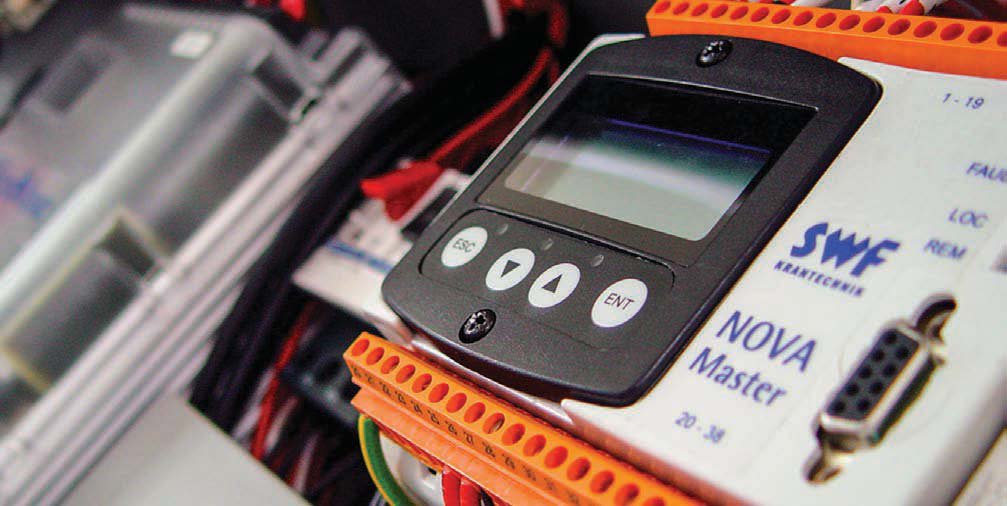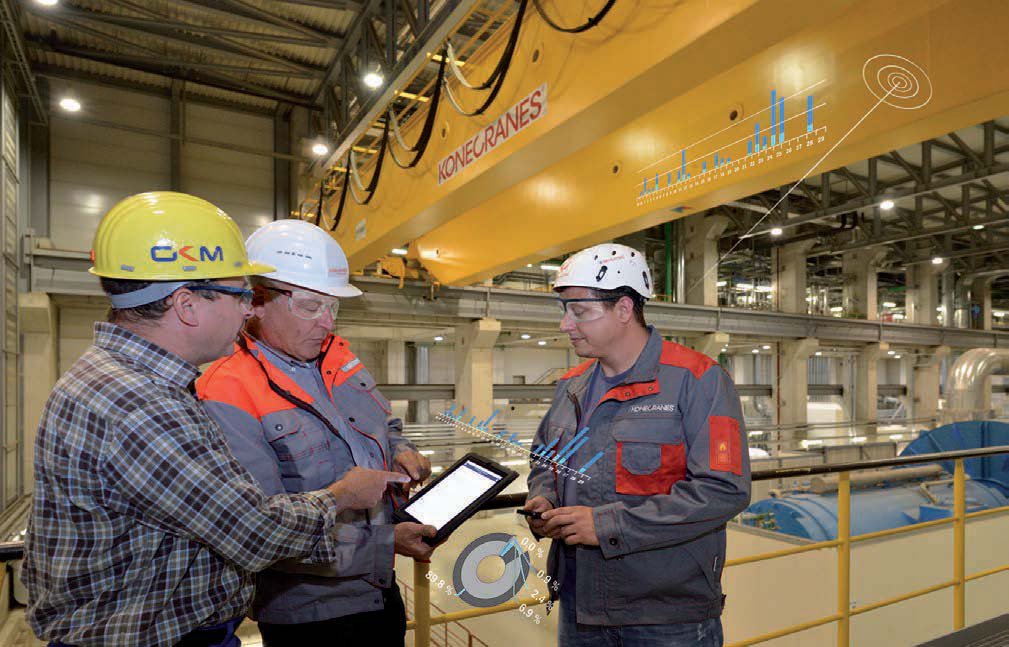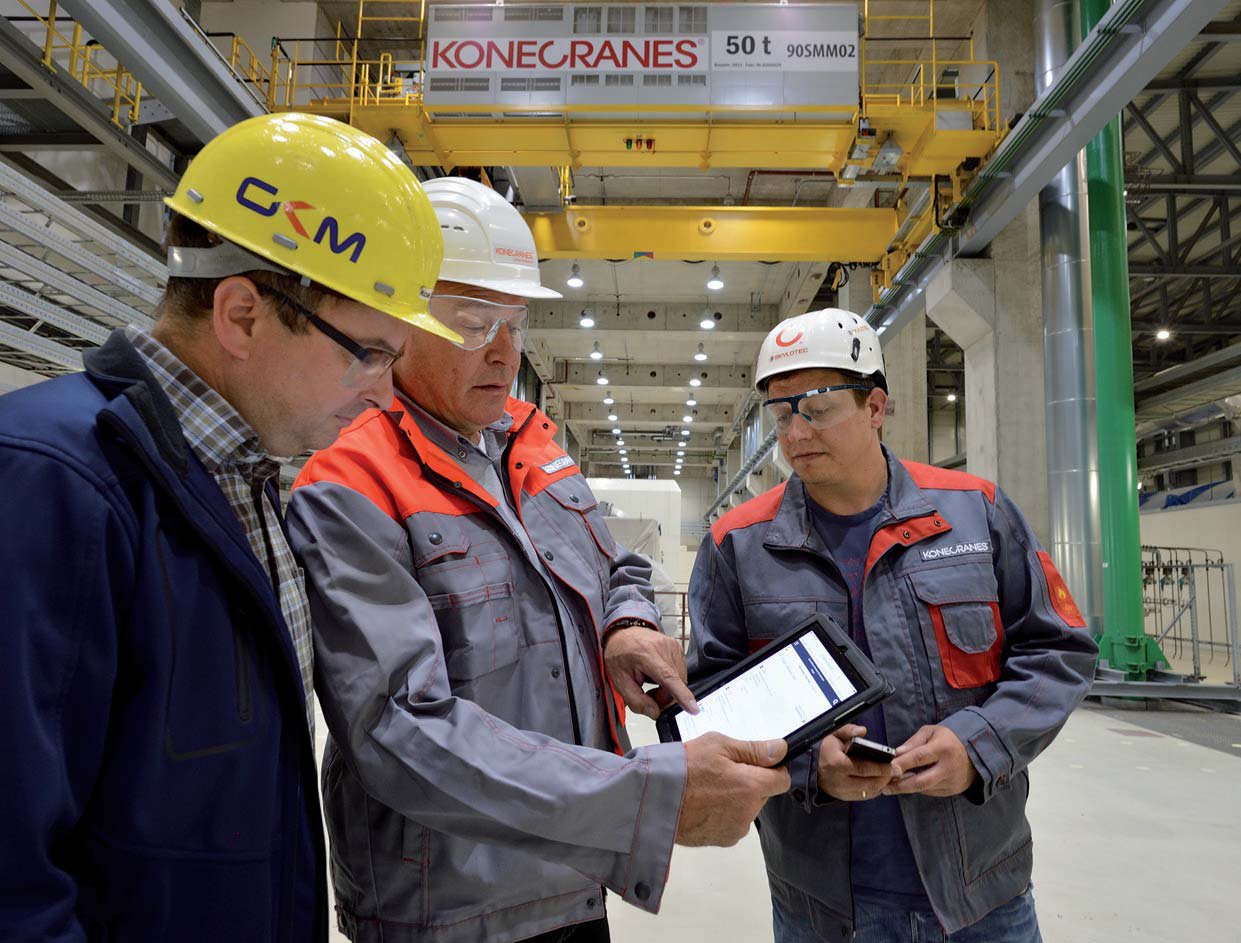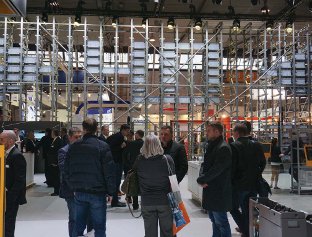Lift smart
23 August 2018The future of factories is the so-called ‘Industry 4.0’, the complete and seamlessly integrated digital control of a production line. Julian Champkin looks at the current state of the art in digitalisation of lifting technology.
Digitalisation is a buzzword in the lifting industry—as it is indeed in many industries— and digital control of cranes and hoists is becoming standard. In manufacturing and in processing, however, a different phrase is current. There they speak of ‘Industry 4.0’ as the goal, which means rather more than digital control of a single machine. How does the current state of digital control in lifting equipment tie in with it?
In lifting, digital control is currently strongly focussed on increasing safety. Construction and mobile cranes have digitalised load charts whose software warns the operator when a load radius limit is being reached; hoists in production facilities have safety limit zones digitally programmed into them that automatically prevent the hook entering areas where collisions might occur or operatives might be at work. Improved reliability is a second focus of digitalisation, and is also becoming standard. Sensors record data from a crane or hoist and send it, generally wirelessly, to a central unit.
“The more data is supplied, on more subjects—speed, position, load, running hours—and over a longer time, the more accurate a picture can be built up of the units working history—and the more precisely the danger-points, of where the unit might fail, can be predicted. Software can spot patterns, trends and anomalies in the data,” says Wayne Branton, vice president Industrial Services EMEA sales for Konecranes. Thus predictive and preventative maintenance is greatly improved. SWF Krantechnik has also worked on bringing the benefits of digitalisation to the overhead lifting sector. The company’s NovaMaster offers electronic monitoring to protect against overloading. It can be installed in either a bridge or trolley control panel.
“NovaMaster records, monitors, calculates and saves all relevant crane data, which can be output to a screen or PC,” says managing director Christian Heid. “Hoist monitoring measures wire rope usage and prevents lifting or lowering movements if it detects something that could possibly lead to a dangerous situation. NovaMaster protects the wire rope from overload at all times and automatically calculates the safe working period remaining. Gentle load lifting, acceleration and stopping minimise wear and tear on the motor and brakes and reduces the burden on both the load and crane.” The hardware and software in NovaMaster was custom designed for usage in cranes.
NovaMaster continually monitors a potentially huge number of different parameters. The remaining safe working period of the hoist, and of the brake, the total number of starts, the total operation time of the hoist motor, the number of hub cycles, the loads, average loads, and current load capacity on the hook are just some of them. You can add the current voltage, the total number of cases of overload, the number of emergency stops, the maximum value of the calculated duty factor, the total switch-on time of the crane, hook equalisation, and so on. Fit the appropriate sensor and the data is there for the taking.
These systems have many of the hallmarks of Industry 4.0. They communicate wirelessly, they use the cloud for storage, they are dataintensive, and they greatly improve efficiency.
Today both cranes and hoists can be controlled remotely, by an operator some distance away using joysticks on a wireless control box. This is digital control; but neither this nor NovaMaster nor portals like that of Konecranes are fully yet Industry 4.0, as it has been commonly defined.
The latter is achieved when machine exchanges data with machine—when they ‘talk’ to each other—and, crucially, when each machine can affect the behaviour of the other and mutually interact. Industry 4.0 is about more than smart cranes—it is about smart factories. The vision is of a whole production line, each of whose elements adjust themselves seamlessly in tune with their neighbours. Thus if, say, a press slows down for any reason, the hoist that supplies components to that press will also slow down in synch, and will deliver loads to it less frequently. It will do this without the intervention of a human operator.
For example, the CHP power station at Lohbrügge, Germany and the hoist that feeds it begin to approach this vision. Not only is the hoist computer-controlled, even down to the way in which the grab picks up assorted wood-scraps most efficiently, but it interacts digitally with the rest of the plant. Combining a Demag crane with the Demag warehouse management computer (WMC), it is informed digitally of the presence of a delivery truck and will not then enter certain areas; it receives digital information about the level of fuel in the furnace’s silo and replenishes it automatically when it is low.
It forms an integral part of the overall process, and the system that controls it is designed not to move a hoist but to efficiently produce energy from woodchip. The vision of Industry 4.0 goes even further. Future developments at such a plant might see digital inputs for example predicting energy usage among customers—daily or weekly fluctuations, or even one-off events such as a football World Cup broadcast increasing the local demand for energy—and the furnaces and generators stepping up their output. The cranes and hoists would move faster to enable the furnaces to burn hotter and the generators to produce more power. That degree of digital interconnectedness is not yet a reality. “We are not at that stage yet,” says Branton. “But that is the trend in the industry. That is the way things are moving.”
How much digitalisation will cost depends on the degree of digitalisation that the customer desires. “We follow the philosophy that the use the crane is put to, and the extent of its digital integration into processes, are so varied that an individual assessment has to be done in each case,” says Oliver Kempkes of Kuli. “Even similar-looking functions might require different features and safety levels depending on the use and processes around it.”
Functions like weighing, positioning, synchronisation, logging, remote control and so forth are all candidates for digital monitoring and control; but “the more precise and extensive functions the more efforts are required to implement them,” he says. “For example, if you want to prevent collisions with other equipment, you can either use a simple switch for stopping the crane movement or use a state of the art laser scanning device that also considers the movements of possible colliding objects. Prices therefore are extremely different. The number of possible solutions is growing almost every day. So we see it as our task to consult our customers so as to be able to take the right decision for the digital features that fit their needs as well as their budget.”
So getting to Industry 4.0 is not a onestep process. “The crane industry is focusing more and more on digitalisation and Industry 4.0, whereby connected crane solutions and smart hoists both play an important role,” says Heid, “We at SWF Krantechnik have been working on this topic for quite some time as well as observing the responses in other industries.”
Some sectors, he says, are already a few steps ahead. Nor is it simply a matter of technology having to catch up. Instead, this is such a big stepchange that there are legal, and even philosophical, issues that need to be addressed. Industry 4.0 is about data, and ‘Big Data’; and this is where the issues arise.
“The challenges for our industry are not the technology solutions” says Heid, “but rather critical questions and the correlating legal aspects about data protection, data security and data ownership. There is still a great deal of insecurity in various issues. For example: Where is the data saved? How safe is the data in the cloud? Who owns that data, and who is ultimately responsible for it?” And, last but not least: “How open is the data, and who may access it?”
If these questions sound abstract, they have very concrete effects: “At SWF Krantechnik we are a B2B company so these questions take on an additional dimension,” says Heid. “Our target markets are retailers and independent crane builders that use our components to build custom crane solutions for their end users. That means we also need a secure, viable solution for both our network of partners and their own customers. We are currently working on a future-proof solution to meet the interests of both groups.
“Our customers are currently asking for custom crane intelligence solutions, which are smart electronic monitoring and control devices to optimize process security, handing and ergonomics. We offer multiple solutions that meet various requirements in this area.” He mentions sway control, inching for precise positioning of loads, shock prevention to lift loads gently, and control of cranes in tandem, to enable simultaneous long and cross travel, lifting and lowering.
All these use digital inputs from sensors; but, Industry 4.0 is not merely about implementing these functions in a single machine. “Users and partners will want to enable communication among these machines and their functionalities in the future. This information, of course, will not just be available for the machine. Every user or service representative can view it—and even control it—online. “For the future, SWF are working on viable remote solutions to connect the operator and the crane system even better” Heid adds. “We have a pilot project that connects data, people and machines and is running successfully at one of our client sites. The remote data transfer, remote diagnostics and analytics create transparent insights on how the crane system is used.”
Projects such as these are at last beginning to approach what full Industry 4.0 is about. We are not there yet. “Industry 4.0 is a work in progress,” says Branton. “That is why it is such an exciting time.”



